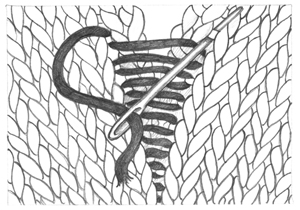This column by Barbara Breiter, author of The Complete Idiot’s Guide to Knitting & Crocheting, originally appeared in The Weekly Stitch newsletter.
 You may see patterns that talk about selvage stitches (sometimes spelled “selvedge”) and wonder what they could be referring to. All fabric has selvages; they are simply the left and right edges of the piece, or the first and last stitch of each row.
You may see patterns that talk about selvage stitches (sometimes spelled “selvedge”) and wonder what they could be referring to. All fabric has selvages; they are simply the left and right edges of the piece, or the first and last stitch of each row.
Some patterns specify to work a selvage stitch; you may notice that directions tell you to always knit the first and last stitch of the row or to slip the last stitch of each row. In these cases, the designer has factored in the selvage as part of the design to make it easier for you. However, if you’re creating your own design from a stitch dictionary or just winging it, understanding how to work those selvage stitches (or identify them, if you’re modifying a pattern), will be very helpful.
When you have pieces you are going to seam together, such as the front to the back of a sweater, you will use these edge stitches for seaming. They won’t be visible after the project is seamed. This is particularly useful when you’re creating your own design for a sweater or shrug, which may otherwise end up with yarn-overs and decreases on the edges of the design. Regardless of the pattern stitch used, if you work a stockinette selvage it will make seaming much easier. To do so, simply knit the first and last stitch of every row on the right side and purl them on the wrong side. If a stitch pattern is used, you might check and be sure that the pattern has allowed two extra stitches for seaming so you have a full repeat across after seaming.
For projects that will have raw row edges such as afghans and scarves, a decorative selvage will create a nice looking row edge that will make all the difference in its appearance. Even if the piece has an edging pattern knit in such as seed stitch (work the first and last three stitches in seed stitch for example), you can still use one of these decorative selvages.
The Slipped Garter Selvage has a small horizontal bar between a stitch that is elongated because it has been slipped.
Row 1: With yarn in back, slip the first stitch as if to knit, work across the row (in your chosen pattern) to the last stitch, knit.
Repeat Row 1.
The Chain Selvage appears as a chain (really just elongated slipped stitches) on each edge. It looks very clean and neat. Try to keep an even tension to maintain this look.
To work this selvage:
Row 1 (RS): With yarn in back, slip the first stitch as if to knit, work across (in your chosen pattern) to the last stitch, knit
Row 2: With yarn in front, slip the first stitch as if to purl, work across to the last stitch, purl
Here’s an alternative way to work this selvage:
Row 1: With yarn in front, slip the first stitch as if to purl, work across (in your chosen pattern) to the last stitch, knit.
Repeat Row 1.
One note about selvages for raw edges: while these create nice, neat-looking edges, they are not friendly for seaming, so be sure to work the stockinette selvage mentioned above.
–-
To sign up for the Weekly Stitch and get columns like this, free patterns, how-to videos and more, click here.
How To Do 4 Different Types of Selvages | Yarn Buyer
[…] http://blog.lionbrand.com/2014/08/04/how-to-do-4-different-types-of-selvages/ […]